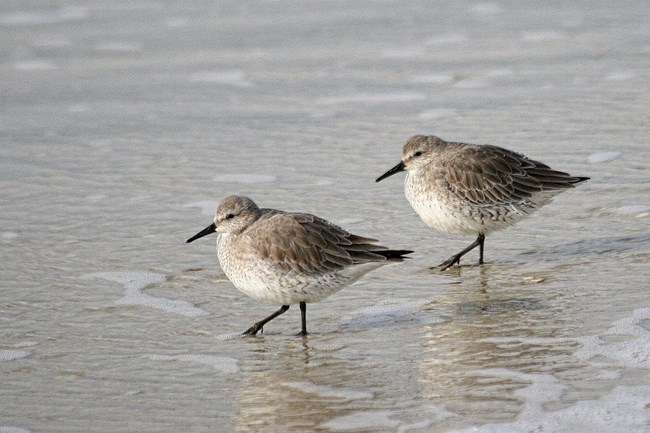
NPS Red knots have been spotted at Fort Matanzas from December to May in recent years. They are essentially a large, bulky type of sandpiper with a short, straight, black bill and greenish legs. Their coloration is non-descript, at least in the non-breeding season (such as when they’re in Florida)- grayish to off-white. They are mostly seen feeding along the shoreline and on emergent sand bars in the river. Their favorite foods include bivalves (like coquina clams), small snails, and crustaceans. The reasons for their precipitous decline in population numbers are varied, but one of the main reasons has to do with the decline of horseshoe crabs in Delaware Bay. Red knots have one of the most long-distance migrations of any species, taking some groups from the Arctic to Tierra del Fuego at the southern tip of South America (and back!) each year. One of the most crucial spots for them to rest and re-fuel on this nearly pole-to-pole trip is Delaware Bay, historically known for its multitudes of horseshoe crabs. The knots’ arrival at the bay is timed to coincide with the horseshoe crab breeding season when they release millions of eggs into the water. It is these eggs which the knots gorge upon to build up their energy reserves for the rest of their long flight. Unfortunately the number of horseshoe crabs in the bay plummeted due to overharvesting, a situation that was not reversed until 2012. In addition, coastal development throughout its range has reduced the knot’s wintering and migratory habitat. Another crucial stopover point for the red knot is located right here in Florida, at the Fort George Inlet in Jacksonville. Fortunately this inlet is protected by Timucuan Ecological and Historic Preserve and Little Talbot Island State Park. Turns out Florida has been a preferred destination for snowbirds long before Henry Flagler made it stylish to winter in the Sunshine State! |
Last updated: April 17, 2021
